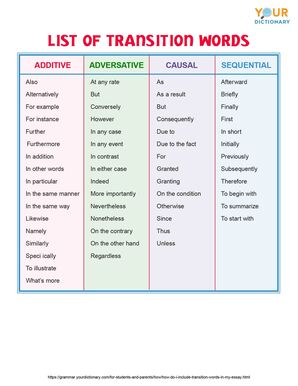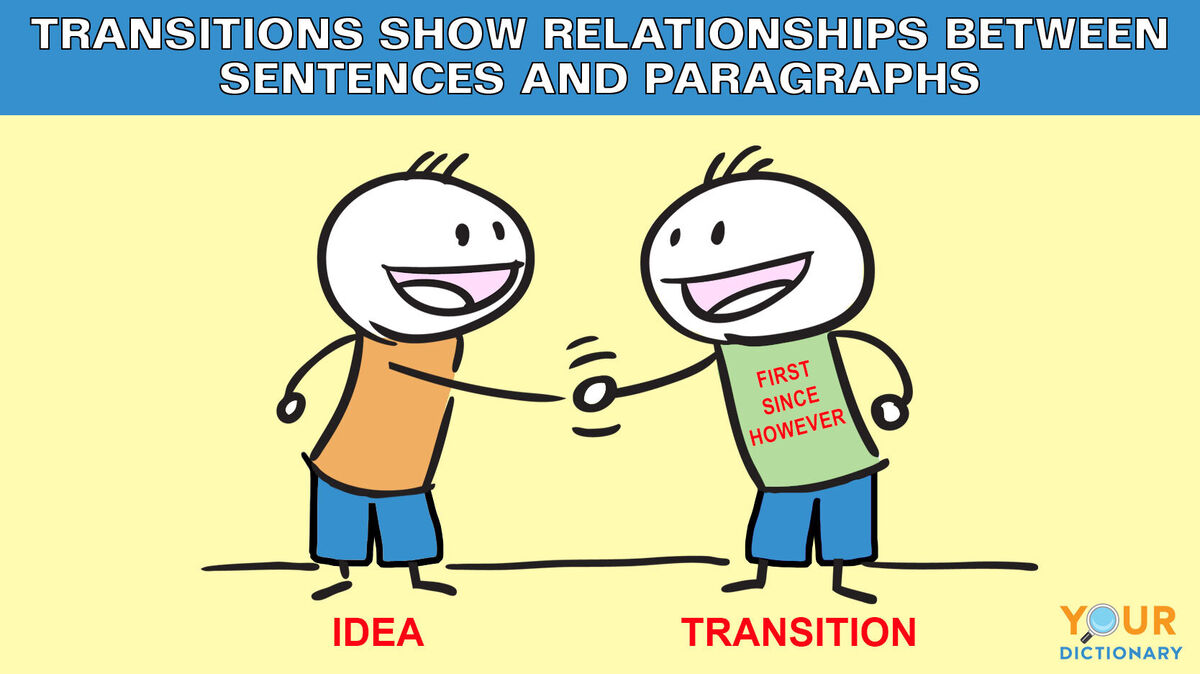

English teachers often ask students to include transition words in their essays. Transition words connect ideas in sentences and paragraphs. Therefore, they're an important part of writing.
Using Transition Words
Have you ever talked to someone who jumped around a lot in their conversation? It can be difficult to follow their train of thought. Well, transition phrases prevent your writing from doing a similar thing.
Sequential words like "first," "second," "then," and "afterward" are great for organizational purposes. But you can also tie thoughts together with words like "nevertheless" or "however." Even simple words like "and" and "but" can tie sentences and paragraphs together in informal writing.
- The process of writing an essay is quite simple. First, you should start with a great idea and brainstorm some details for it.
- Some might argue that liberal arts education is unimportant in today’s economy. However, this couldn’t be further from the truth.
- Making a casserole is a multi-step process that can be confusing for some beginning cooks. But a good set of instructions can help.
Here are some tips on how to use transition words in an essay.
1. Keep Transition Words in Mind as You Plan
Transition words run the risk of being overused. The key to using them efficiently is to add enough to make the reader understand the points being made without using so many that the phrases become cumbersome. Let's look at the writing process, which will help you decide where to place them and how often to use them.
Transition Words in the Writing Process
The only way to get better at writing is to do more writing. As for transitions, try a few different ones on for size. Let's review the writing process:
- brainstorming
- outlining
- drafting
- revising
- editing
Noting Transitions in Your Outline
Planning an outline will help you see where you need to place transition words and tie your thoughts together. Then, as you enter into your first draft, you'll already have your needle threaded and can neatly sew your paragraphs together.
1. Introduction - Write a personal anecdote about being a new student.
2. Many students must make a school transition due to moves, etc. (Possible transition: “I was not alone in the experience of changing schools.”)
3. Social connections are important for student success. (Possible transition: “As a result of these transitions, social connections become very important.”)
4. Lunch groups and other programs help new students socialize and can make a difference. (Possible transition: “However, there are a number of ways schools can help.”)
5. Conclusion - Provide a summary and restate thesis. (Possible transition: “In short, schools have a responsibility …”)
Even after the draft is complete, transition words can still be added to the revision and editing stage. Having a list of transition words available may help you with word placement.

2. Decide Where to Place Transitions
The versatility of transition words makes them easy to place. Knowing where to place these words or phrases will allow you to easily insert them.
Transition Word Placement in Sentences
Transition words can go almost anywhere in a sentence, including the beginning, middle and end. The key is that the transition word refers back to the previous thought or forward to the next thought.
For sentences, transition words can be placed:
- at the beginning of the sentence - Afterward, the doctor will decide the best course of treatment for you.
- in the middle of a sentence - The patient, however, was still in a lot of pain.
- at the end of a sentence - The treatment was quite effective by comparison.
Transition Word Placement in Paragraphs
Linking paragraphs is an important consideration when you’re choosing transition words for essays. Each paragraph needs to be linked to the one before it or the one after. As you’re writing, add on transition words to form these connections.
For paragraphs, transitions can be found:
- at the beginning the paragraph - Next, it's important to consider patient care.
- at the end of the paragraph - With patient care addressed, it's time to move on to charting.
3. Consider the Relationship of What You’re Connecting
When you’re connecting two things in your writing, those two things can have various relationships. Think about the things you’re connecting. How are they connected? These are some of the options.
Additional Information
One sentence or paragraph may add extra information that supports or further explains what you’ve already written.
There are many reasons to consider a standard poodle as a pet. Specifically, if you are allergic to dogs, this breed can be a good choice.
Disagreement
Sometimes, one point or paragraph disagrees with the previous one or adds a conflicting view.
Some schools use uniforms to help reduce the chance a student will be bullied for her clothing. However, there is little evidence uniforms help reduce bullying.
Cause and Effect
In some cases, one point is connected to another by cause and effect.
The emerald ash borer spreads quickly and silently through populations of ash trees. Because of this hidden spread, homeowners are often surprised to see their ash trees infested with the pest.
Chronology
Sometimes, things happen in order, and your transition words can show this order.
When my mom got home from the grocery store, she looked anxious. After I had helped her put the groceries away, she told me what had happened.
Summary
One paragraph may offer a summary of the previously communicated information.
For all of these reasons, mobile banking is both a convenient and safe alternative to in-person transactions.
4. Choose the Right Transition Words
Since transitions show relationships among sentences and paragraphs, recognizing the types of transitions will help you choose the most appropriate one. The following chart can help you find the right transition word for a specific use.
Additive Transitions
These transitions add or introduce information. They can also be used to show similarities or to further clarify ideas. Some examples of additive transitions include:
also | in addition | likewise |
alternatively | in other words | namely |
for example | in particular | similarly |
for instance | in the same manner | specifically |
further | in the same way | to illustrate |
furthermore | indeed | what's more |
Adversative Transitions
These transitions show readers' conflicts, contradictions, dismissals, or emphasis. Some examples of adversative transitions include:
at any rate | in any event | nevertheless |
but | in contrast | nonetheless |
conversely | in either case | on the contrary |
however | indeed | on the other hand |
in any case | more importantly | regardless |
Causal Transitions
These transitions show the relationship of cause and effect or consequence. Some example of causal transitions include:
as | due to the fact | otherwise |
as a result | for | since |
but | granted | therefore |
consequently | granting | thus |
due to | on the condition | unless |
Sequential Transitions
These transitions show the reader chronological sequences in time or provide a sequence to a logical argument. Some examples of sequential transitions include:
afterwards | in short | therefore |
briefly | initially | to begin with |
finally | previously | to summarize |
first | subsequently | to start with |
5. If in Doubt, Repeat a Word or Phrase
If you aren’t sure what transition word to use in your writing or what the relationship is between two paragraphs, you can create a transition by repeating a word or phrase. Look at the final sentence of one paragraph and use one or more of the words in the first sentence of the next paragraph. Here’s an example:
Taking a photograph is mostly about looking at the light and how it falls on a subject. Does it come from the front, enveloping the subject evenly? If so, it sometimes makes sense to take the photo from a different angle, giving shadows a bit more of a place in the image.
Giving shadows a place is important because they help add dimension to your image …
The Power of Transitions
Think of transition words as the thread that stitches a piece of clothing together. They provide uniformity and cohesion to essays in particular. If you’re writing an essay, it might also be helpful to keep this transition word lists for students by your side for your next assignment.